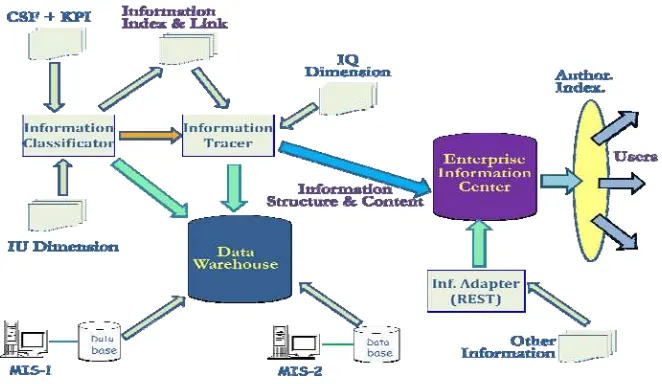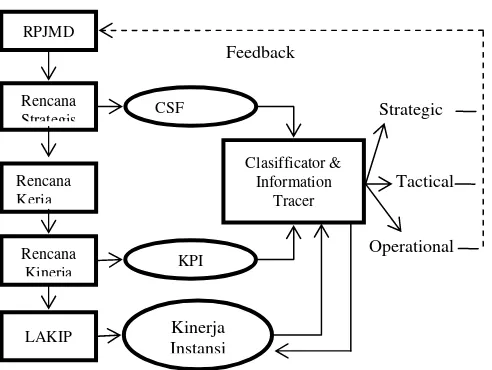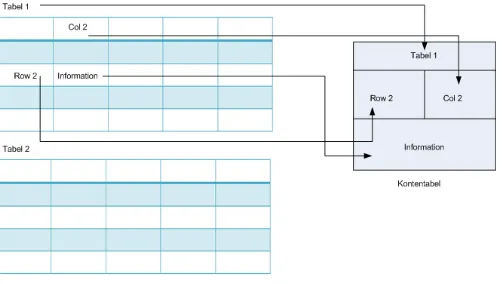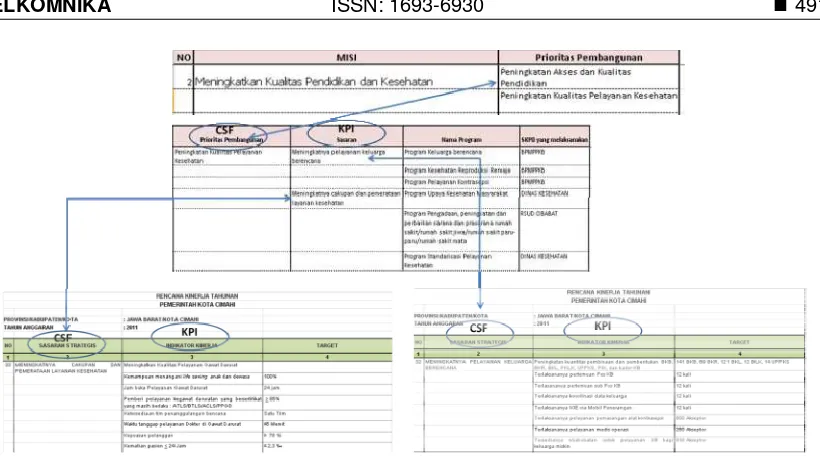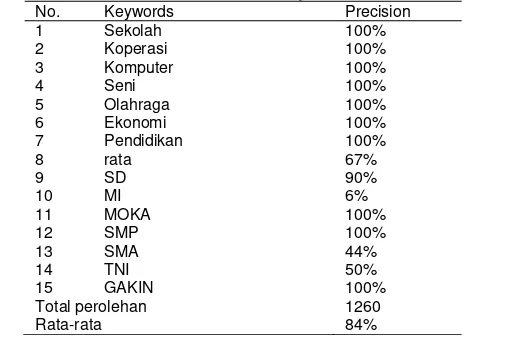DOI: 10.12928/TELKOMNIKA.v12i2.2058 485
Information Interchange Layer based on Classification
of Information Use (IU)
Albarda Supangkat*,S.H Kuspriyanto Sembiring, J
School of Electrical Engineering & Informatics (STEI), Institut Teknologi Bandung Gd. Bakrie Lt. 3 Jl. Ganeca 10 Bandung, Indonesia, phone/fax. 62 22 2500985
*Corresponding author, e-mail: albar@stei.itb.ac.id
Abstract
Information characteristics in classification of IU directly related to aspects of information usage by user in enterprise to accomplish their activities. Feature extraction from information usage in three layer of enterprise management used as parameter for this characteristic. Characteristics and dimension applied to develop middle-ware system (called Information Interchange Layer) that bridges a common issue ie information silo, to optimize a services of information resources in enterprise.
Keywords: Information Characteristic, Information Use, IS, Information Management, Information Resource
1. Introduction
In last decade it’s so easy to access, store, produce, and distribute information to or from global source of information. Most executives of enterprises began to realize that amount of information will not valuable if it irrelevant and unable to provide added value for them. In fact, although investment value is growing rapidly but development of Information System and Technology (IST) frequently incapable to meet the expected impact. Most of real problem are flow of information stalled or not fit to expectation (causing Information Silo). Compatibility and Inter-Operability between systems or units is often a difficult obstacle to addressed. System integration, particularly to meet a requirement of information exchange between systems, become a strategic issues to ministry level in Indonesia. Most strategic impact perceived is ineffective to provide a right information, accurate, and timely, especially for top management, beside its flow between internal units in enterprise.
DeLone & McLean [1] has developed D&M Information Systems (IS) success model since 1991 and generates 5 aspects whose influence it. Information Quality or IQ [2] is the only aspect on D&M model which specifically separates a study to elements of information as a product with its information systems. IQ is measure of information characteristic because be a dimension which is directly representing information, especially as a product of information systems. Factor of poor information quality is considered as the most influential aspect for enterprise. Many of the IQ problems are pervasive, costly and even disastrous [3]. One of a purposes in applying theories and concepts of many IQ research is to conduct a most appropriate improvement based on this characteristics to produce high-value information.
In line with observations in previous description about availability of right information, according to Garvin 1993 [4], one of the basic things that become a problem in quality of information management is inappropriate format. Appropriateness format are subjective and more closely related to its usage process. Therefore, can be indicated there is information characteristics which related indirectly to a system that produces information, but highly related to its use. Adopted from Choo [5] used a term of Information Use (IU) as a classification of information characteristic in usage stage or based on characteristics of its user. Characteristics on classification of IU to be evaluated is appropriateness format, which is in this study defined as fitness between information available with interests of its user. Focus of this study is to analyze the application and effect from characteristics to management of information interchange within enterprise.
information in different formats customized to characteristics of its users. The objective is to evaluate the usefulness of the characteristics on IU as factors directly related with effort to provide more high value. To ensure that a characteristics will be evaluated are not included in classification of IQ, this trial used information sources that already available to ignore the influence from a system generating such information.
Success of this trial is expected to have implications that this design can be implemented to build a middle-ware system and will be capable as an 'interchange layer' between various of operational information systems and between the other types of information. Such systems are should be able to integrated with other information systems either existing, which are being or will be developed (generic properties) to meet the needs and interests at tactical and strategic layer in enterprise.
2. Conceptual Of Research
Model which describes a formation of information has grown since introduction of Information Theory by Shannon in 1948. After Mason in 1978 developed a more detailed model, then developed D&M Model [1] which generates its 5 influence aspects, where information is product received, used, and directly affects to user (individual impact). Two parameters of D&M Model, used as a main classification from characteristics of information, ie.:
IQ as a classification for dimensions of qualitative value from content of information that is produced by the system,
Use or Information Use (IU), which in this paper is focused as a classification for dimensions of categorical value from process of information usage, as product of a system.
Characteristics of information that has been developed so far, represented as a dimension of information quality (IQ). Such dimensions identified by user's perception of information about a quality attributes that should exist in an information. Wang & Strong (1996) identify and define 16 dimension. Ge [3] separates the dimensions were direct related to value of data/information and indirect (as supporing). Classification for phases of information also developed with model for process of Information Management Cycle [5]. The cycle of process start from defining a clear and detailed a need of information from whole enterprise (Information Need), determining a method to get (Information Acquisition) until process for usage of information intensively by users (Information Use). Subsequently observed of influence both for users and the enterprise (Adaptive Behaviour), hereafter will re-affect to process of Information Need (cyclical). Model adopted from Choo can be seen at figure below.
Figure 1. Information Management Cycle (modified from original by Choo 2002)
Seen from figure above that we classify a processes of information management from Choo into 6 stages, whereas 4 stages are related to the value creation of information. In that Figure 4 processes in information management cycle can be grouped into 2 phases: Production
and Delivery. IS as object of study in many researches related to D&M model and IQ, were in Production phase, while IU characteristics as object of study in this paper, were in Delivery.
We acquired a basic characteristics on classification of IU ie Relevance, which is we define as a fitness dimensions between available information to the users interests. In this study we will analyzed and applied a perspective on the level of information use within enterprise as a factors of quantification for characteristic of Relevance [6],[7]. Our Expectation is to obtain a categorical value for a quantitative level of IU that more clear in weighting for value of information on three layers: 1) operational, 2) tactical, and 3) strategic, in terms of impact for enterprise. Any information generated by any system will be classified based on direct impact for this three layers. Analysis for a various type of information within enterprise, related to a needs of 3 layers of management, generating a features extraction of information usage in enterprise (Mustaqiem 2011, Harita 2012 from [5]). Extraction yield the following table.
Table 1 Feature of Information in Management Level [5]
Operational Tactical Strategic
Function Data Entry Monitoring Decision
Review Routine Periodical Temporarily Information Periode Short
daily~monthly
Medium monthly~yearly
Long
multi-year Completeness Detail
log file
Form Report Summary/ Recapitulation %/Graphic/ Diagram
Resulting feature list above are parameters used to obtain a characteristics on IU. This paper outlined a verifying of concept for information characteristics on Delivery phase as connecting from information content which is output of Production phase with impact for its users. Characteristics on classification of IU from Table 1. used as a parameter of specification for application design to repackaging information so it can be a basic solution for a Format issue. Design of applications that will be a main application modules, aims to be able to produce high quality information as resources for enterprise. In this case, information that presented in more appropriate format with interests of its users will be able to provide a higher benefits or added value, that means also will give a higher benefit impact for enterprise.
This application is also intended as a solution to another issue was common in enterprise ie as a bridge of Information Silo. Information generated from various of information systems will rearranged further so it can be used between department from enterprise and also provide information that is precise, accurate, and fast for a top-layer managers, especially top management.
3. Application Of Concept
Generic middle-ware system which mentioned earlier is still a conceptual system and we named 'Information Interchange Layer' (IIL). These system serves as container that can accommodate for interchange of various types of information from various sources, arrange and repackaging according to needs of information management in 3 layers. Or in other words, becomes a connective part for three layers of management in enterprise. Design of IIL system developed from analysis of service requirement in this layer and characteristics contained in classification of IU.
Figure 2. Design of IIL
The main parts of IIL were:
• Data Ware-house: a place to accommodate various types of data/information from various sources or providers (include IS), which will be used as a main source of IIL,
• Classificator: subsystem which have capability to generate a list of keywords from various documents sources that will be used as index in a retrieval process, as well as index for restructure process of information. In this study, a list of keywords based on a IU characteristics that corresponds to management layer in local government of Indonesia, • Information Tracer: subsystem that have capability to search and extract information from
many sources or documents in accordance with specifications, then compose a results into information that is more concise, relevant, and corresponds to list of keywords including a results of Classificator) ,
• Enterprise Infromation Center (EIC): as a site to store and organize information from extraction and classification result in a new information structure.
Algorithm of applications based on applying IU characteristics which obtained from feature extraction as a hint for parsing and extracting a document containing CSF (Critical Success Factor) and KPI (Key Performance Indicator) and resulting a list of keywords accordance with a measurement pattern of IU characteristic. Characteristics and keywords are obtained, used as an index to optimize a repackaging process of information to fit for users and applicable in general. 4 features from table of Feature Extraction (Table 3.) was used as a parameter of information classification, i.e.: function, completeness, event-related, and form of information. Information presented for a layer of operational management is usually complete, that mean all of details from the past must presented. At a layer of tactical management, information presented as a pointers at present (recapitulation and its criterion). At a layer of strategic management, information presented as a brief or summary and measurements or benchmarks of achievement to the future (including in chart format).
Figure 3. Flow of Information in LAKIP
We made observations and give results that optimizing a flow and interchange of information most effectively carried out at a tactical layer [8], which is in integration and recapitulation process to operational reports documents. Practical issue was recapitulation process often undertaken manually in preparing a report like this. As a result, a decline occur in value of information characteristic especially for dimension of time, beside of course adversely affecting for presentation formats. It also led to flow bottlenecks of information to a strategic management layer. Moreover, almost all of report documents above, is no longer in structured information form so it can be used to evaluate that these characteristic are independent to a system whose generates such information.
Some sources of documents from one of local governments in Indonesia (RPJMD, RKPD, RENSTRA, RKT) and information or documents from Critical Success Factors (CSF), Key Performance Indicator (KPI), and other important documents use as material that will be repackaging, using technology of Information Retrieval [9] and particular algorithm that has been made. Repackaging of information conducted by: extraction, recapitulation, classification, and storage of information by applying a particular tools such as Classificator and Information Tracer which has been described above.
Classificator generating a list of keyword by designing an application modul that able to parsing and extract a keywords from documents, normalizing a results from keyword extraction with a lexicon-based, and structuring a links between all documents. Modul for Classificator are:
• Extractor
Search and Parsing a words that correspond to a keywords and retrieve a whole of information containing a words from document source. Information referred is description on corresponding column. Especially for initial process, used RPJMD as a document source with keyword is "Misi" (mission).
• CSF-KPI Normalization
Normalization of information from extracted result based on dictionary (lexicon-based) that has been created such that able to recognize a structure of sentence in standard Indonesian Language and is also able to recognize the characteristics of "good" CSFs [10] and KPIs [11], [12]. This study uses three characteristics of KPI: specific , measurable , and time-based. The results are statement that conform to standard sentence of CSF-KPIs.
• CSF-KPI Generator
Generate a CSFs and KPIs statement, including new keywords from a statement.
Generate a linkage structure of information between documents, including a keywords classifying and tagging to appropriate management layer.
Information Tracer has primary function to execute a repackaging of information. This subsystem consists of three main modules, namely: Searching, Extractor, and Storage. In addition to use a concept of Information Retrieval [9] for developing algorithm to Searching and
Extractor, also made an algorithm to retrieve a string from the measurement values of KPIs that will be used to present information in graphical form.
One of a results obtained from application of Information Tracer is a storage structure of information which contain an ID from multiple input documents and information package that containing a keyword required. A new storage structure as a class of KontenTabel which will be a basic structure of EnterpriseInformation Center EIC - (from Figure 2.)
Figure 4. Design of Information Structure for EIC
Storage structure (EIC) that already contain information that has been classified and arranged based on needs from each of management layer then will be accessible to used as a source for other systems or delivered directly corresponds to a keywords and classification of users in each layer of management through a various ways. For example, selected information can be directly sent as a message (via SMS, IM, push-mail, etc.) or through information system for Executive (EIS).
4. Application Result
Below is implementation and testing conducted for both subsystem as a main part of IIL system design, and also shows an evaluation for use of characteristic on IU.
4.1 Subsistem Classificator
Prototype was implemented by applying an algorithm of Extractor - Normalization - Generator for all documents of LAKIP related (start from RPJMD) to generate a list of keywords index and links between all documents. Figure 5. and 6. following shows an example of algorithm applied for some sample of source documents.
Also proceed a design verification, both to technical specifications required (with experts judgement) and to user requirements i.e personal was directly involved with documents management. In general, a verification results show that this prototype has meet a criterias.
4.2 Subsistem Information Tracer
Figure 5. Implementation of Classificator
Figure 6. Result from Classificator (list on the Right)
Table 2. Precision testing for several of keywords (for field of education)
From study above demonstrated that basic application of IIL is able to perform a repackaging and generate new information more appropriate format to needs and interests of users. In other words, a parameters proposed for characteristic of IU capable of functioning as a parameters to produce higher quality information. Design of models and system concepts is still preliminary study that needs to be developed further. But more or less will change a paradigm of information management in context of information resources that rise its complexity in enterprise.
IIL that serves as a middle-ware for a various existing information systems and various sources of information will also increasing value of assets from Information Resources in enterprise. By placing IIL as part of the information network infrastructure from enterprise will give more effective impact for tactical and strategic interests. That mean are providing information resources which capable to produce a high value of information to decision support for executives or managers. This will facilitate for management of investment strategy in context of information governance for enterprise.
References
[1] DeLone WH, McLean ER. The DeLone and McLean Model of Information System Success: A Ten Year Update. Journal of Management Information Systems. 2003; 19(4): 9–30.
[2] Madnick SE, Wang RY, Lee YW, Zhu H. Overview and Framework for Data and Information Quality Research. ACM Journal of Data and Information Quality. 2009; 1(1).
[3] Ge M, Helfert M, Jannach D. Information Quality Assessment: Validating Measurement Dimensions and Processes. ECIS Proceedings. 2011: 75.
[4] Al Hakim L. Challanges of Managing Information Quality in Service Organizations. London. Idea Group Publishing. 2007.
[5] Choo CW, Bergeron P, Detlor B, Heaton L. Information culture and information use: An exploratory study of three organizations. Journal of the American Society for Information Science and Technology. 2008; 59(5): 792-804.
[6] Albarda. Classification of Information Use (IU) on the Information Resource Services. The Proceedings of the 6th International Conference on Telecommunication System, Services, and Applications (TSSA 2012). Kuta Bali. 2012: 153-156.
[7] Roslaeni D, Albarda. Design of Keyword Extraction Application as a Part of Information Center. International Conference on ICT for Smart Society. Jakarta. 2013; 1-9.
[8] Nasution WS, Albarda. Improvement of Business Process in order to Manage the Quality of Information. International Conference on ICT for Smart Society. Jakarta. 2013; 1-7.
[9] Kowalski G. Information Retrieval Architecture and Algorithms. Springer. Ashburn, VA, USA. 2011. [10] Howell MT. Critical Success Factor Simplified: Implementing The Powerful Drivers of Dramatic
Business Improvement. New York. CRC Press. 2010.
[11] Permenter D. Key Performance Indicators: Developing, Implementing, and Using Winning KPIs. John Wiley & Sons Inc. New Jersey. 2010.
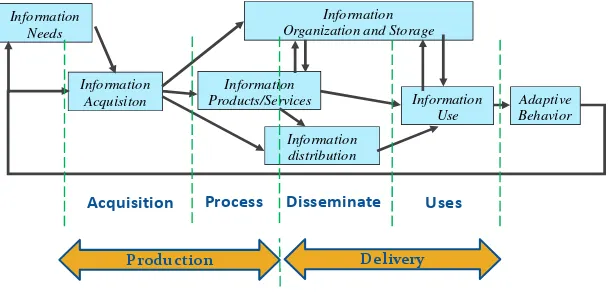
![Table 1 Feature of Information in Management Level [5]](https://thumb-ap.123doks.com/thumbv2/123dok/246869.503768/3.595.92.505.253.371/table-feature-information-management-level.webp)
